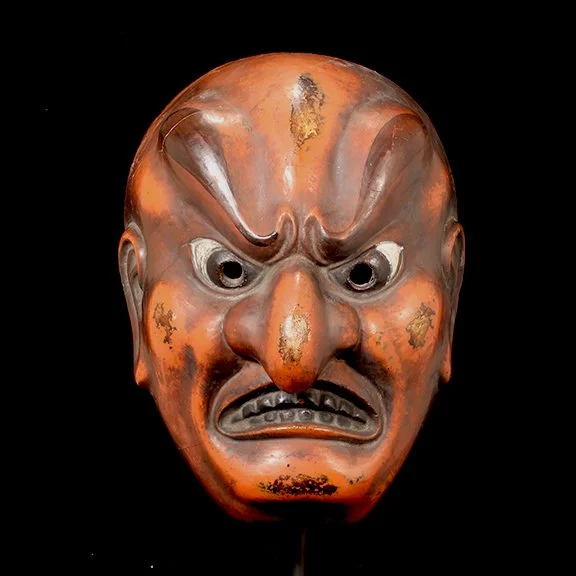
Past Exhibitions
Exhibitions
Japanese Noh Theatre Mask Online Exhibition
Japanese Noh masks originated in the14th-century during the Muromachi period (1392-1573). Noh means "talent". Noh is a major form of classical Japanese dance-drama based on traditional literature that has been performed since the 14th century. While the exact origins are unclear, it's believed that the Noh masks and their names, still used today, were developed during this time. Prior to this period, masks had stronger religious connotations, but they gradually took on more human characteristics as performers focused on expressing yūgen (mysterious beauty) and profundity. In the story, a supernatural creature transforms into human shape and tells the story. The actors tell a story through gestures and appearance in masks. They capture the essence of the story with masks, props and costumes through dance performance.
Noh is an art form that utilizes masks. Noh masks are carved from a single piece of wood painted with natural pigments, and there are a great variety of them. Masks represent age, gender and social ranking of human or nonhuman being-like animals, demon or divine. All of the masks have a distinctive name. There are 60 types and over 400 different masks representing particular characters. With the intention of stimulating the imagination of the audience of Noh play, a Noh mask is utilized to emphasize and stylize the facial expressions which are accompanied with appropriate body language and movement.
Covering the face with a mask is much like wearing makeup. However, Noh performers feel that the Noh mask has a certain power inherent in it, which makes it much more spiritual than a prop used to change one’s appearance. Considering the status of a certain Noh, the Noh performer will carefully choose a Noh mask, known also as a Noh-men or omote. In most cases, the exact mask is not predetermined, but depending on which Noh is being done, the shite or main actor has a variety to choose from. In the end, it is up to the shite to make the final determination as to which mask is chosen.
By the early Edo Period, most mask types had become highly standardized, leaving mask carvers with little room for creativity or innovation on the front of the mask. As a result, some mask carvers began to focus more attention on the back of the mask as an outlet for their artistic expression. When carving the back of a Noh mask, artisans must keep several factors in mind.
Anatomical Accuracy: The interior must be shaped to fit the contours of a human face while allowing enough space for comfort and breathing.
Balance: The weight distribution of the mask is crucial. Proper carving of the back helps to achieve the right balance, making it easier for the actor to wear and manipulate the mask during performances.
Acoustics: The interior shape affects the resonance of the actor's voice. Skilled carvers understand how to optimize this for better sound projection.
Ventilation: Adequate space must be provided for the actor to breathe comfortably, especially during long performances.
Noh masks continue to be appreciated and admired, representing a rich tradition of Japanese culture, art, and history that has endured since the 14th century.
For further information and purchases, please contact John Buxton at 972-239-4620 or jbuxton@arttrak.com. All prices quoted include the custom mount, but do not include shipping or insurance. We recommend shipping via UPS ground. Gallery will assist in packing for a modest charge. Shipping charges via UPS can be added to the purchase price or the buyer can make their own arrangements.
Tribal Art Jewelry Show
Tribal art jewelry refers to a collection of objects crafted by indigenous artisans that embody significant African, Pre-Columbian, Oceanic, and Native American cultural meanings and traditions. This type of jewelry is characterized by its use of local materials and traditional techniques, resulting in unique, handcrafted items that reflect the identity and heritage of specific tribal communities. The origin of these pieces range from before Christ to the 20thcentury.




























